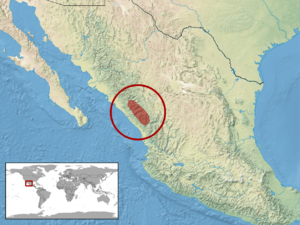Crotalus stejnegeri facts for kids
Quick facts for kids Crotalus stejnegeri |
|
|---|---|
| Conservation status | |
| Scientific classification | |
| Genus: |
Crotalus
|
| Species: |
stejnegeri
|
 |
|
The Sinaloan long-tailed rattlesnake (scientific name: Crotalus stejnegeri) is a special type of venomous snake. It's a pit viper, which means it has heat-sensing pits on its face. This snake lives in western Mexico. It's also called the long-tailed rattlesnake. There are no different kinds (subspecies) of this snake known.
Contents
Why is it called Crotalus stejnegeri?
This snake's scientific name, stejnegeri, honors a famous scientist. His name was Leonhard Stejneger. He was a herpetologist, which means he studied reptiles and amphibians. Mr. Stejneger worked at the Smithsonian Institution for more than 60 years.
What does the Sinaloan Long-tailed Rattlesnake look like?
Adult Sinaloan long-tailed rattlesnakes are usually not very long. Most grow to about 60 cm (24 in) in total length. The longest one ever found was 72.4 cm (28.5 in) long.
This snake has a tail that is quite long compared to its body. For male snakes, the tail makes up about 11% to 14.8% of their total length. For females, it's a bit shorter, around 9.8% to 12.5% of their length.
Scientists have noted that this snake's rattle is very small. Because of its size, the rattle probably doesn't make much noise. This snake is also very rare. Only 12 specimens have ever been found by scientists.
Where does the Sinaloan Long-tailed Rattlesnake live?
The Sinaloan long-tailed rattlesnake lives in western Mexico. You can find it in the mountains and foothills of eastern Sinaloa. It also lives in western Durango and small parts of northern Nayarit.
These snakes live at altitudes between 500 and 1,200 meters (1,640 to 3,937 ft) high. They prefer different types of forests. These include pine-oak forests, subtropical dry forests, and tropical deciduous forests.
Is the Sinaloan Long-tailed Rattlesnake in danger?
Yes, the Sinaloan long-tailed rattlesnake is considered a vulnerable species. It is listed as "Vulnerable" on the IUCN Red List of Threatened Species. This list helps us know which animals are at risk of disappearing.
A species is called vulnerable if its living area is small. For this snake, its known habitat is less than 20,000 km2 (7,720 mi2). It also means its habitat is broken up, or it lives in very few places (no more than 10).
Scientists have seen that its habitat is shrinking or getting worse. This means the snake faces a high risk of becoming extinct in the wild. When it was last checked in 2007, the number of these snakes was going down.


